Simulation games have always fascinated players. These games let you do amazing things like running a city, managing a farm, or even flying a plane. The history of simulation games is full of interesting stories and big changes. It started with simple games like SimCity and has grown into the world of VR sims that we know today. But how did this genre begin? And how has it changed over time?
In this article, we’ll explore the history of simulation games. We’ll look at the first games that started it all, and how this genre has grown into something huge. Whether you’re a fan of simulation games or just curious, this guide will take you through the past, present, and future of simulation games.
What Are Simulation Games?

A Simple Definition
Before we dive into the history of simulation games, let’s first understand what they are. Simulation games, or sims, are video games that let you copy real-life activities or systems. For example, in SimCity, you manage a city. In The Sims, you control the daily lives of virtual people. There are also games like Microsoft Flight Simulator, where you can fly a plane just like a real pilot.
These games let you play around with systems, solve problems, and make decisions. You control what happens, and you get to see the results of your choices. Some games aim to be realistic, while others are just fun and creative.
Main Features of Simulation Games
Most simulation games have these key features:
- Realism: These games often try to feel like real life. For example, in a farming sim, you plant crops, water them, and wait for them to grow.
- Management: You usually control a system. This could be a city, a farm, or even a rollercoaster park. You make decisions that affect how the system works.
- Player Choices Matter: What you do in the game changes what happens next. Your decisions shape the world around you, and every choice has a result.
Now that we know what a simulation game is, let’s look at how they started and how they grew over time.
The Start of Simulation Games
SimCity and Will Wright (1989)
The history of simulation games really took off in 1989 when Will Wright created SimCity. This game was a big deal because it let players control a whole city. You were in charge of everything from building roads to making sure people had jobs. What made SimCity different from other games was that there was no clear way to win or lose. You could keep building your city for as long as you wanted.
SimCity was one of the first games where players had the freedom to make their own fun. You could design your city however you liked, and you had to deal with real-life problems like traffic or pollution. This kind of open-ended gameplay became very popular, and it set the stage for many other simulation games.
Sid Meier and Railroad Tycoon (1990)
Around the same time, another important game came out: Railroad Tycoon, created by Sid Meier in 1990. In this game, you built and managed a railroad business. You had to lay tracks, buy trains, and make money. Like SimCity, this game wasn’t about beating levels—it was about making smart decisions and managing a system.
Railroad Tycoon added business management to the world of simulation games. Players didn’t just build things—they had to think about how to make money and grow their company. This mix of strategy and simulation was a big hit and influenced many future games.
Little Computer People (1985): The Early Life Sim
Before The Sims became a massive hit, there was another early life simulation game called Little Computer People. Released in 1985, it let you watch a character live inside a virtual house. You didn’t control the character directly, but you could give them suggestions and see how they reacted.
While simple, Little Computer People showed that players liked the idea of interacting with virtual people. It paved the way for more complex life simulation games like The Sims later on.
Simulation Games in the 1990s and Early 2000s

City-building Games
After SimCity’s success, many other city-building games followed. These games were similar but often added more detail. Some popular games from this time include:
- Caesar (1992): This game let you build cities in ancient Rome.
- Pharaoh (1999): You built and managed cities in ancient Egypt, focusing on pyramids and temples.
- Tropico (2001): You played as the leader of a small island nation, managing politics, economics, and the happiness of your people.
These games took what SimCity started and added new layers of strategy. You didn’t just build cities—you had to deal with history, politics, and resource management. Players loved the challenge and creativity these games offered.
The Sims (2000): A Game-Changer in Life Simulation
In 2000, Will Wright released another groundbreaking game The Sims. This time, instead of managing a city, you controlled individual people. You built their homes, helped them make friends, and guided them through their daily lives. The Sims was different because it focused on life itself. You could decide if your Sims became successful or struggled.
The game became an instant hit. It was simple to pick up but offered deep gameplay for those who wanted to dive in. The Sims showed that people enjoyed life simulation just as much as building cities or managing businesses. It became one of the best-selling PC games of all time and led to many expansions and sequels.
Sandbox Simulations and Freedom to Play
Open-ended Sim Games
Another big part of the history of simulation games is the rise of sandbox-style games. These games let you create and explore without strict rules or goals. You had the freedom to build and play however you liked. Some popular sandbox simulation games include:
- SimCity 2000: A more advanced version of the original, where you could build more detailed cities.
- RollerCoaster Tycoon: A game where you build and manage your own theme park, complete with rollercoasters and other rides.
In these games, you weren’t trying to “win” by beating levels. Instead, the goal was to create something amazing. Players loved this freedom, and it became a major feature of simulation games.
Resource Management Games
Another type of simulation game that became popular was resource management. In these games, players focus on gathering and using resources wisely. For example:
- Anno 1602: You build colonies, manage resources, and trade with other nations.
- Factorio: You build factories and automate production to grow your industrial empire.
These games tested players’ ability to plan and manage systems over time. They required long-term thinking and strategy, making them challenging but very rewarding.
Simulation Games Today: VR and Beyond

VR Simulation Games
As technology improved, simulation games kept getting better and more realistic. Today, virtual reality (VR) is changing how we play simulation games. VR lets players step inside the game world and interact with it in new ways. Popular VR simulation games include:
- Job Simulator: A fun game where you perform everyday tasks in a virtual office or kitchen.
- Flight Sim VR: A super-realistic flying experience where players can pilot planes in a fully immersive world.
With VR, simulation games feel more lifelike than ever before. Players can now see and interact with virtual worlds as if they were really there.
Blending Simulation with Other Genres
Today, many games mix simulation elements with other genres. For example:
- Stardew Valley combines farming with role-playing.
- Subnautica is a survival game with resource management and exploration.
Even big games like Red Dead Redemption 2 use simulation elements to create detailed, living worlds where players’ choices shape the game.
Conclusion
The history of simulation games is full of creativity and growth. From the simple days of SimCity to the cutting-edge world of VR sims, this genre has always been about giving players the freedom to create, manage, and explore.
At Gamespublisher.com, we understand the importance of these games in the video game industry. Whether you’re a game developer looking to learn from the past or a publisher seeking new trends, exploring the history of simulation games can offer valuable insights. By understanding where the genre has been and where it’s going, developers and publishers can create even more exciting experiences for gamers everywhere.
Stay tuned to Gamespublisher.com for more in-depth articles on the evolution of gaming genres and insights into the latest trends in the gaming industry. We’ll help you stay ahead of the curve and give you the tools to keep innovating.
Loading survey...

